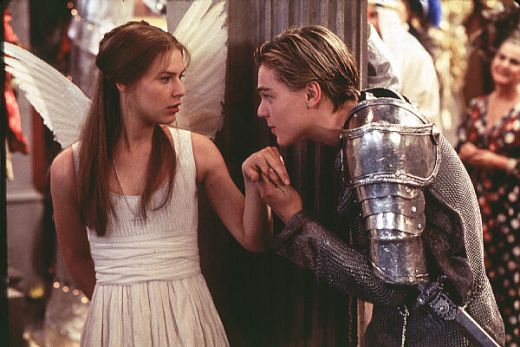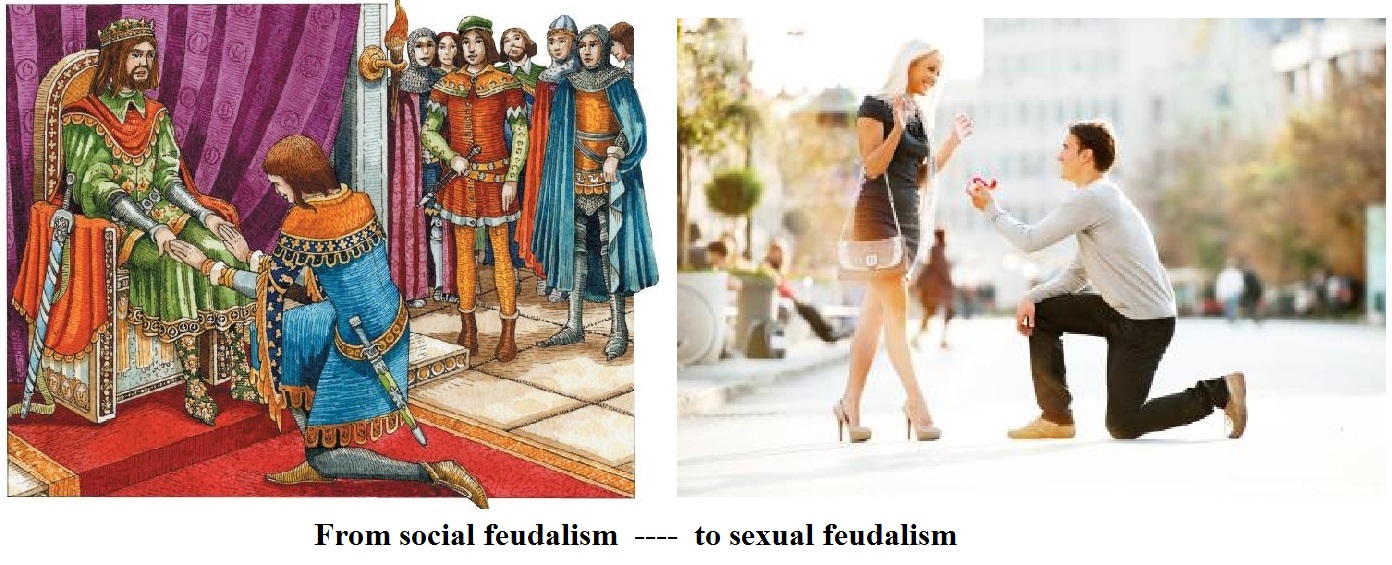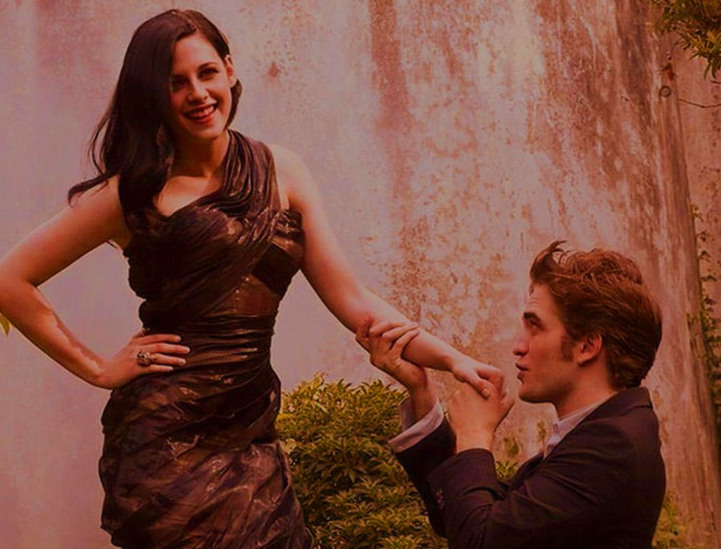The gynocentric model for conducting relations between the sexes today comes from old Europe in the forms of damsaling, chivalry and courtly-love. The tradition began in 12th century France and Germany and spread rapidly to all the principle courts of Europe. From there it filtered into popular culture, being transported eventually to the new world on the wings of colonial expansion – to the Americas, India, Australia and so on.
Why is this history important to men? Because it’s a history we continue to enact today, unconsciously, and its consequences for men have far reaching psychological implications.
In the medieval model men offered themselves as vassals to women who took on the status of overlords in sexual relations – this because women were widely viewed as men’s moral superiors. As evinced by the first troubadours, men pledged homage and fealty to women who actively played the part of man’s superior. This feudalistic formula, which I will tentatively label sexual feudalism, is attested by writers from the Middle Ages onward, including by Lucrezia Marinella who in 1600 AD recounted that women of even lower socioeconomic classes were treated as superiors by men who, she recounts, “acted as servants or beasts born to serve them.”
Many female and male writers stated this belief, including Modesta Pozzo who in 1590 wrote, “don’t we see that men’s rightful task is to go out to work and wear themselves out trying to accumulate wealth, as though they were our factors or stewards, so that we can remain at home like the lady of the house directing their work and enjoying the profit of their labors? That, if you like, is the reason why men are naturally stronger and more robust than us — they need to be, so they can put up with the hard labor they must endure in our service.”
And there is much more to this model than men laboring for women’s material benefit. It also includes a belief in women’s corporeal, moral and spiritual superiority, of which we shall say more below.
Sexual feudalism
I came to the phrase sexual feudalism as a shorthand for the sex-relations model of gynocentrism, and have since discovered the phrase used occasionally in literature; here are a few examples carrying the same meaning:
Camille Paglia (1990):
“…a sexual feudalism of master-slave relationships.”
Marjolijn Februari (2011):
“Actually it’s arguing for a dictatorship, the dictatorship of the vagina, a kind of sexual feudalism which you wouldn’t want our international relations to be governed by in the future… those women aren’t the least concerned about war and peace as a matter of principle; all they’re concerned about is securing their own interests.”
Adam Kostakis (2011):
“It would not be inappropriate to call such a system sexual feudalism, and every time I read a feminist article, this is the impression that I get: that they aim to construct a new aristocracy, comprised only of women, while men stand at the gate, till in the fields, fight in their armies, and grovel at their feet for starvation wages. All feminist innovation and legislation creates new rights for women and new duties for men; thus it tends towards the creation of a male underclass, the accomplishment of which will be the first step towards the extermination of men.”
“But what are the women’s rights advocated today? The right to confiscate men’s money, the right to commit parental alienation, the right to commit paternity fraud, the right to equal pay for less work, the right to pay a lower tax rate, the right to mutilate men, the right to confiscate sperm, the right to murder children, the right to not be disagreed with, the right to reproductive choice and the right to make that choice for men as well. In an interesting legal paradox, some have advocated – with success – that women should have the right to not be punished for crimes at all. The eventual outcome of this is a kind of sexual feudalism, where women rule arbitrarily, and men are held in bondage, with fewer rights and far more obligations.”
When did it start?
Below are compiled a series of authoritative quotes on the subject. Each points to evidence of the beginnings of sexual feudalism in early Europe, along with other contributing factors such as veneration of the Virgin Mary and its influence on women’s status.
H.J. Chaytor, The Troubadours: “In the eleventh century the worship of the Virgin Mary became widely popular; the reverence bestowed upon the Virgin was extended to the female sex in general, and as a vassal owed obedience to his feudal overlord, so did he owe service and devotion to his lady… Thus there was a service of love as there was a service of vassalage, and the lover stood to his lady in a position analogous to that of the vassal to his overlord. He attained this position only by stages; “there are four stages in love: the first is that of aspirant (fegnedor), the second that of suppliant (precador), the third that of recognised suitor (entendedor) and the fourth that of accepted lover (drut).” The lover was formally installed as such by the lady, took an oath of fidelity to her and received a kiss to seal it, a ring or some other personal possession.”
C.G. Crump, Legacy of the Middle Ages: “The Aristocracy and Church developed the doctrine of the superiority of women, that adoration which gathered round both the persons both of the Virgin in heaven and the lady upon earth, and which handed down to the modern world the ideal of chivalry. The cult of the Virgin and the cult of chivalry grew together, and continually reacted upon one another… The cult of the lady was the mundane counterpart of the cult of the Virgin and it was the invention of the medieval aristocracy. In chivalry the romantic worship of a woman was as necessary a quality of the perfect knight as was the worship of God… It is obvious that the theory which regarded the worship of a lady as next to that of God and conceived of her as the mainspring of brave deeds, a creature half romantic, half divine, must have done something to counterbalance the dogma of subjection. The process of placing women upon a pedestal had begun, and whatever we may think of the ultimate value of such an elevation (for few human beings are suited to the part of Stylites, whether ascetic or romantic) it was at least better than placing them, as the Fathers of the Church had inclined to do, in the bottomless pit.”
C.S. Lewis, The Allegory of Love: “Everyone has heard of courtly love, and everyone knows it appeared quite suddenly at the end of the eleventh century at Languedoc. The sentiment, of course, is love, but love of a highly specialized sort, whose characteristics may be enumerated as Humility, Courtesy, and the Religion of Love. The lover is always abject. Obedience to his lady’s lightest wish, however whimsical, and silent acquiescence in her rebukes, however unjust, are the only virtues he dares to claim. Here is a service of love closely modelled on the service which a feudal vassal owes to his lord. The lover is the lady’s ‘man’. He addresses her as midons, which etymologically represents not ‘my lady’ but ‘my lord’. The whole attitude has been rightly described as ‘a feudalisation of love’. This solemn amatory ritual is felt to be part and parcel of the courtly life.”
Joan Kelly, Did Women have a Renaissance?: Medieval courtly love, closely bound to the dominant values of feudalism and the Church, allowed in a special way for the expression of sexual love by women… if courtly love were to define itself as a noble phenomenon, it had to attribute an essential freedom to the relation between lovers. Hence, it metaphorically extended the social relation of vassalage to the love relationship, a “conceit” that Maurice Valency rightly called “the shaping principle of the  whole design” of courtly love… Thus, in Medieval romances, a parley typically followed a declaration of love until love freely proffered was freely returned. A kiss (like the kiss of homage) sealed the pledge, rings were exchanged, and the knight entered the love service of his lady. Representing love along the lines of vassalage had several liberating implications for aristocratic women. Most fundamental, ideas of homage and mutuality entered the notion of heterosexual relations along with the idea of freedom. As symbolized on shields and other illustrations that place the knight in the ritual attitude of commendation, kneeling before his lady with his hands folded between hers, homage signified male service, not domination or subordination of the lady, and it signified fidelity, constancy in that service.”
whole design” of courtly love… Thus, in Medieval romances, a parley typically followed a declaration of love until love freely proffered was freely returned. A kiss (like the kiss of homage) sealed the pledge, rings were exchanged, and the knight entered the love service of his lady. Representing love along the lines of vassalage had several liberating implications for aristocratic women. Most fundamental, ideas of homage and mutuality entered the notion of heterosexual relations along with the idea of freedom. As symbolized on shields and other illustrations that place the knight in the ritual attitude of commendation, kneeling before his lady with his hands folded between hers, homage signified male service, not domination or subordination of the lady, and it signified fidelity, constancy in that service.”
Peter Makin, Provence and Pound: “William IX calls his lady midons, which I have translated as ‘my Lord’. This midons is, as Pound said, ‘inexplicable’: it is used by the troubadours, of their ladies, and in the later troubadours we find it everywhere–Bernart de Ventadorn used it twenty-three times. Its etymology is (?mi-) dominus, ‘my master, lord’, but since it is used only of women – its pronoun is ‘she’ – glossarists have difficulty assigning it a gender. Though Mary Hackett has shown that it was not felt to mean on the primary level ‘my quasi-feudal lord’ by the troubadours who used it, these men knew their Latin and must have been aware of its origins and peculiarity; in fact it was clearly their collective emotions and expectations that drew what amounts to a metaphor from the area of lordship, just as it is the collective metaphor-making process that establishes ‘baby’ as a term for a girlfriend and that creates and transforms language constantly. In the same way, knowing that Dominus was the standard term for God, and that don, ‘lord’, was also used for God, they must also have felt some connection with religious adoration. William IX echoes the scriptures when he says
and every pride obey Midons…
No one can find a finer lady,
nor eyes see, nor mouth speak of…
The incantatory fifth stanza of this song enumerates powers that were evoked every day in the Virgin and the saints. William IX is, metaphorically, his lady’s feudal vassal as well as her worshipper. So that there are three structures in parallel: the feudal, the courtly-love, and the religious; the psychological structure of each followed that of the others, so that it was difficult to think of any of them without transferring the feelings that belonged to the others. The lady was to lover as God to man, and as feudal lord to vassal; and feudal lord to vassal was as God to man. Our socio-economically minded age would say that the forms of feudal society must have shaped relationships in the other two spheres, and it is as likely that aesthetics and ethics moulded economics and vice versa. Of course, courtly love was not ‘religious’ in the sense of being part of any Christian ethic; it was a religion in its psychology. The courtly lover did not think of his lady as the Church thought of her, but as the Church thought of God.”
Irving Singer, Love: Courtly and Romantic: “Since the social structure of the Middle Ages was mainly feudal and hierarchical, men were expected to serve their lords while women were required to show fidelity. In courtly love this was transformed into meaning that the lover would serve his lady and that she would be faithful to him. Courtly love is often said to have placed women on a pedestal and to have made men into knights whose heroic lives would henceforth belong to elevated ladies. The idea arises from the fact that men frequently used the language of chivalry to express their servile relationship to whatever woman they loved, and sometimes they described her as a divinity toward which they might aspire but could never hope to equal… that he must prove himself worthy of her and so advance upward, step by step, toward a culminating union at her level; that everything noble and virtuous, everything that makes life worth living, proceeds from women, who are even described as the source of goodness itself. But though the lady now discourses with her lover, the men frequently cast themselves into the typical posture of fin’amors. On their knees, hands clasped, they beg the beloved to accept their love, their life, their service, and to do with them as she pleases.”
Gerald A. Bond, A Handbook of the Troubadours “The extent of the penetration of feudal thought into the conception and expression of courtly love has been apparent to all modern investigators: the poet-lover portrays himself as a vassel (om), the lady is treated as a feudal lord and often addressed in masculine form (midons/sidons), and contracts (conven), reward (guizardon), and other aspects of loyal and humble service are constantly under discussion. In a profound sense, courtly love is quintessentially feudal (Riquer 77-96), for it imitates the primary hierarchical principles increasingly employed to control as well as to justify hegemonic desire in the second feudal age.”
Sandra R Alfonsi, Masculine Submission in Troubadour Lyric “The troubadours lived and functioned within a society based on feudalism. Certain ones were themselves feudal lords; others were liegemen dependent on such lords for their sustinence. The troubadours who were members of the clergy were also actively involved in this feudal society. It is only natural that their literature reflect some traits of the age in which it was created. Scholars soon saw striking parallels between feudalistic practices and certain tenets of Courtly Love. The comparisons lie in certain resemblances shared by vassalage and the courtly “love service.” Fundamental to both was the concept of obedience. As a vassal, the liegeman swore obedience to his lord. As a courtly lover, the poet chose a lady to whom he was required to swear obedience. Humility and obedience were two concepts familiar to medieval man, active components of his Weltanschauung. Critics, such as Erich Kohler, have found them exhibited in both the life and literature of that time.
The entire concept of love-service was patterned after the vassal’s oath to serve his lord with loyalty, tenacity, and courage. These same virtues were demanded of the poet. Like the liegeman vis-a-vis his sovereign, the poet approached his lady with fear and respect. Submitted to her, obedient to her will, he awaited a fief or honor as did the vassal. His compensation took many forms: the pleasure of his lady’s company in her chamber or in the garden; an avowal of her love; a secret meeting; a kiss or even le surplus, complete unity. Like the lord, the woman who was venerated and served was expected to reward her faithful and humble servant. Her failure to do so was considered a breach of “contract.” Most critics who support the theory that the courtly-love-service was formed by assimilation to the feudal service inherent in vassalage, credit Guillaume IX with its creation. However, the universality of these parallels cannot be doubted:
The posture of the true lover is so familiar that we have come to accept it as the hallmark. A seal attributed to Cononde Bethune represents it perfectly. This depicts in an oval cartouche, an armed knight on his knees before a lady. His body is shrouded in a mail hauberk. His head is completely concealed in his helmet. He wears spurs but no sword. The lady stands at arms length, chastely robed, her regular nonedescript features framed in long braids, presumably blonde, and between her outstretched palms the knight’s hands are placed in the formal gesture of homage. Within the cartouche, in the space above the helmet of the kneeling knight is inscribed a single word: MERCI. 1
The similarities between courtly service and vassalage are indeed striking. Although of a more refined character than an ordinary vassal, the poet-lover is portrayed as his lady’s liegeman, involved in the ceremony of homage and pictured at the moment of the immixtio manuum. His reward for faithful service will doubtlessly include the osculum.
The influence of feudalism upon courtly love was, in my opinion, twofold: it provided the poets with a well-organized system of service after which they might pattern their own; it furnished them with a highly developed vocabulary centered around the service owed by a vassal to a lord. Feudalistic vocabulary was comprised of certain basic terminology indicative of the ties which legally bound a man to his lord in times of peace and war.
Sexual feudalism today
Despite occasional hand-wringing by the media about a decline in chivalric service to women, it appears to be alive and well. Not only are males continuing to go down on one knee to pop the question as dutiful vassals, but sexual feudalism remains a popular staple of romance novels, Disney movies, cinematic blockbusters such as Twilight, and in popular music like Taylor Swift’s Love Story which celebrates courtly love. Men are still willing to die, work, provide for, adore, and pedestalize women, and women are only too happy to be treated to such a dignifying display.


You must be logged in to post a comment.